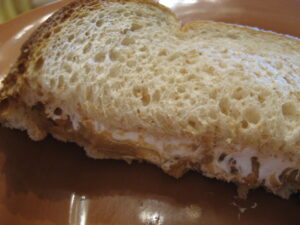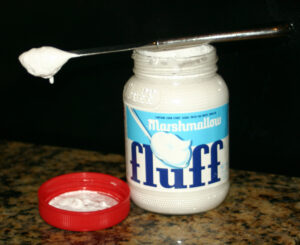By Sharon Oliver, Contributing Writer

LYNN – PB&J may be an old favorite and peanut butter coupled with banana slices might be a craving for others, but when it comes to many people in Massachusetts, especially Baby Boomers, peanut butter mixed with marshmallow fluff is an iconic sandwich of their childhood. Dubbed “fluffernutter” by an advertising agency hired by Durkee-Mower in 1960 as a means to market the sandwich, the fluffernutter is made with marshmallow crème, a confectionery marshmallow spread that was invented in Massachusetts.
Origin stories vary
As to who actually created the sandwich, well, there are two versions regarding fluffernutter’s origin. One story is that Archibald Query began making and selling batches of sandwiches door-to-door in his hometown of Somerville in 1917. After his business failed due to a sugar shortage and rationing during World War I, Query sold the rights to his recipe to childhood friends and business partners H. Allen Durkee and Fred Mower of Swampscott in 1920 for $500.
Another claim is that the idea came from Emma and Amory Curtis, the great-great-great-grandchildren of Revolutionary War hero Paul Revere. Legend has it that Armory created the marshmallow spread called Snowflake Marshmallow Crème (SMAC) in the basement of his home in Melrose in 1901. The Curtis Marshmallow Factory was established in the early 1910s and Snowflake became the first commercially successful shelf-stable marshmallow crème. Even though other companies manufactured similar products, Emma had a gift for marketing and popularized their marshmallow crème by offering recipes like sandwiches featuring nuts and marshmallow crème which were shared in a weekly newspaper column and radio show. By 1915, Snowflake was sold nationwide.
Supporting the war effort
During World War I, Americans were urged to make a sacrifice of eating meat only one day a week. In 1918, Emma Curtis published the recipe for her “Liberty Sandwich” (peanut butter and marshmallow crème) and suggesting people could still obtain their daily nutrients while supporting the wartime effort.
However, in 1915, the confectioners trade journal Candy and Ice Cream published a menu of lunch choices that candy shops could advertise besides hot soups. One item was the “Mallonut Sandwich,” which consisted of peanut butter and “marshmallow whip or mallo topping” spread over lightly toasted whole wheat bread.
Tributes and recognition

Whatever its true origin, fluffernutter is a registered trademark of Durkee-Mower of Lynn. In 1930, the company sponsored a 15-minute radio variety show, “The Flufferettes,” to market their popular confection. Each episode was basically one long ad but had to be presented as entertainment to comply with noncommercial radio regulations. In 2006, Durkee-Mower sued Williams-Sonoma, Inc. in the U.S. District Court for the District of Massachusetts, alleging the cookware and home furnishings retailer infringed on its trademark by selling a marshmallow and peanut butter chocolate-covered candy under the Fluffernutter name.
Hardcore fluff fans celebrate their famous after-school snack every October 8 (National Fluffernutter Day) and with the annual Fluff Festival in Somerville, where fans enjoy music, games and a cooking contest based around fluff and fluffernutters. In 2006, a proposal was made in the state assembly to make fluffernutter the official sandwich of Massachusetts and that same year it became a new Brigham’s Ice Cream flavor. The proposal failed, after spending a full week deliberating.
One side argued that the beloved peanut butter and marshmallow crème combination contributed to childhood obesity. On the other hand, history lovers contended that the fluffernutter was a culinary legacy. One passionate state representative proclaimed, “I’m going to fight to the death for Fluff.” Nevertheless, the ice cream was a big hit that year.
Merriam-Webster added the word fluffernutter to its dictionary in 2021 and in 2011, NASA astronaut and Lowell native Richard Michael Linnehan ate a fluffernutter while aboard the International Space Station and participated as one of the Fluff Fest contest judges.
RELATED CONTENT:
The Massachusetts man who created America’s doughnut habit (fiftyplusadvocate.com)
How Earl Tupper turned one product into a household name (fiftyplusadvocate.com)
‘Spag’s’ – a Shrewsbury retail institution for more than half a century (fiftyplusadvocate.com)












